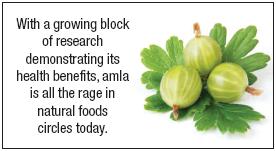Answer for today’s Daily Double: This yellow–green fruit is about the size of a lemon, has a bitter taste and has six vertical stripes around its rounded shape. It also contains more potent antioxidants than vitamin C, and may reduce the effects of arthritis and osteoporosis as well as lower cholesterol. The answer to this Jeopardy! question: What is Amla? We would also have accepted Indian gooseberry, which is another name for this traditional Ayurvedic medicinal herb. Increasingly popular with consumers, and with a growing block of research demonstrating its health benefits, amla is all the rage in natural foods circles today.
Superfruit Extraordinaire
When amla fruits are fully ripe, they take on a slightly reddish tinge. The nutrients that are ready to burst from every amla fruit body are delivered in several different forms. Consumption of the dried fruit itself is growing and also increasingly popular are extracts from the fruit in dietary supplements. It also has been used as an ingredient in medicinal teas, and is available in supplement form as a liquid tincture or a past e.
e.
While many amla products tout the fruit’s high vitamin C content, it has actually been demonstrated to contain comparatively less of the nutrient (1). What it does contain are tannins, which are polyphenols that have antioxidant effects. The health benefits stemming from amla’s high concentration of tannins can include lowered blood lipids, improved blood circulation and interference with the growth of harmful carcinogens (1). Together, these benefits are part of the reason amla has traditionally been used as an ingredient in anti-aging solutions.
Osteoclasts are cells responsible for bone loss and rheumatoid arthritis. One study has shown that extracts of amla can consistently induce apoptosis, or cell death, in these osteoclasts (2). The extract is thought to interfere with the expression of genes involved in osteoporosis and arthritis. The evidence was strong enough for the paper’s authors to suggest extract of amla as an alternative therapy for these ailments (2).
Supplementing a diet with amla may deliver another commonly desired health benefit. A paper in The British Journal of Nutrition details the effects of a diet supplemented with amla in rats. When fed an extract of amla for a period of time, subjects with metabolic syndromes marked by high cholesterol experienced some improvement. The researchers concluded that amla’s polyphenol-rich extract protects against these metabolic disorders by reducing total cholesterol levels (3). Older studies have established this effect in human models. Indian gooseberry was found to reduce cholesterol levels in men aged 35–55 (4).
The List Goes On
Amla has been cited for improving a variety of other conditions. In addition to its antioxidant capabilities, it is a proven anti-inflammatory agent, and has been indicated for reducing bleeding gums as well as macular degeneration (loss of vision with age). It may prove effective in controlling coughing fits, and may prevent the triggering of certain symptoms like runny nose and allergic asthma. Furthermore, regular use of amla as a supplement has been linked to cosmeceutical benefits including healthy hair, bones, teeth and nails (5). One formulation of amla extract has been applied successfully as a protectant from the sun’s harmful rays when used as an anti-aging cosmetic cream. Another study demonstrated that amla can increase the production of collagen, which is essential for the maintenance of healthy skin (6).
Finally, amla has historically been used in Indian Ayurvedic tradition as a digestive aid, and it has been shown to stimulate gastric juices and support detoxification (6). According to one supplier of amla, the herb also has “antibacterial and astringent properties that potentially support the management of infections and help in the healing of ulcers.” WF
References
1. Institute for Traditional Medicine, “Emblic Myrobalans: Amla,” www.itmonline.org/arts/amla.htm, accessed Apr. 22, 2010.
2. L. Penolazzi, et al., “Induction of Apoptosis of Human Primary Osteoclasts Treated with Extracts from the Medicinal Plant Emblica officinalis,” BMC Complementary and Alternative Medicine 8 (59) (2008).
3. H.Y. Kim, et al., “The Protective Role of Amla (Emblica officinalis Gaertn.) Against Fructose-Induced Metabolic Syndrome in a Rat Model,” Brit. J. Nutr. 103 (4), 502–512 (2010).
4. A. Jacob, et al., “Effect of the Indian Gooseberry (Amla) on Serum Cholesterol Levels in Men Aged 35–55 Years,” Eur. J. Clin. Nutr. 42 (11) 939–944 (1988).
5. M.A. Kuhn and D. Winston, Winston & Kuhn’s Herbal Therapy & Supplements (Lippincott Williams & Wilkins, Philadelphia, PA, 2008).
6. Sabinsa Corporation, www.saberry.net/cosmeceutical.html, accessed Apr. 30, 2010.
Published in WholeFoods Magazine, July 2010 (pub. online ahead of print, June 21, 2010)










